Antileishmanial activity of a tetralone isolated from ampelocera edentula, a Bolivian plant used as a treatment for cutaneous Leishmaniasis
Fecha
1994Autor
Fournet, A
Angelo Barrios, A
Muñoz, V
Hocquemiller, R
Roblot, F
Cavé, A
Metadatos
Mostrar el registro completo del ítemResumen
Abstract.
The stem bark of Ampelocera edentula Kuhlm. (Ulmaceae) is used by the Chimanes Indians from Bolivia for the treatment of cutaneous leishmaniasis caused by the protozoan Leishmania braziliensis. A chloroform extract of the stem barks was found to be active against extracellular forms of Leishmania ssp. and Trypanosoma cruzi at 50 micrograms/ml. Bioassay-guided fractionation of this extract allowed us to isolate one active compound. Its structure was elucidated by spectral and chemical studies as 4-hydroxy-1-tetralone. BALB/c mice infected with L. amazonensis (PH8) or L. venezuelensis were treated one day after the parasitic infection with 4-hydroxy-1-tetralone (25 mg/kg/day) or with reference drug, Glucantime (56 mg Sbv/kg/day) for 14 days. Lesion development was the criteria used to evaluate the disease severity. 4-Hydroxy-1-tetralone was slightly less effective than the reference drug against L. amazonensis or L. venezuelensis. Single treatment near the site of infection, 14 days after infection with L. amazonensis, with 4-hydroxy-1-tetralone (50 mg/kg) was more effective than Glucantime (112 mg/kg). This study is, to our knowledge, the first to show the activity of a tetralone for the experimental treatment of New World cutaneous leishmaniasis.

